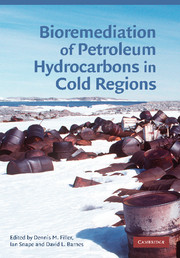Book contents
- Frontmatter
- Contents
- List of contributors
- Preface
- Glossary
- 1 Contamination, regulation, and remediation: an introduction to bioremediation of petroleum hydrocarbons in cold regions
- 2 Freezing and frozen soils
- 3 Movement of petroleum through freezing and frozen soils
- 4 Hydrocarbon-degrading bacteria in contaminated cold soils
- 5 Temperature effects on biodegradation of petroleum contaminants in cold soils
- 6 Analytical methods for petroleum in cold region soils
- 7 Treatability studies: microcosms, mesocosms, and field trials
- 8 Nutrient requirements for bioremediation
- 9 Landfarming
- 10 Thermally enhanced bioremediation and integrated systems
- 11 Emerging technologies
- References
- Index
10 - Thermally enhanced bioremediation and integrated systems
Published online by Cambridge University Press: 22 August 2009
- Frontmatter
- Contents
- List of contributors
- Preface
- Glossary
- 1 Contamination, regulation, and remediation: an introduction to bioremediation of petroleum hydrocarbons in cold regions
- 2 Freezing and frozen soils
- 3 Movement of petroleum through freezing and frozen soils
- 4 Hydrocarbon-degrading bacteria in contaminated cold soils
- 5 Temperature effects on biodegradation of petroleum contaminants in cold soils
- 6 Analytical methods for petroleum in cold region soils
- 7 Treatability studies: microcosms, mesocosms, and field trials
- 8 Nutrient requirements for bioremediation
- 9 Landfarming
- 10 Thermally enhanced bioremediation and integrated systems
- 11 Emerging technologies
- References
- Index
Summary
Introduction
It is well established that microbial activity is slower at low temperatures, and that there is a corresponding decrease in biodegradation rates (Paul and Clark 1996; Walworth et al. 1999; Scow 1982; Ferguson et al. 2003b; discussed in Chapter 4). As temperatures fall to near the freezing point of water, biomineralization of hydrocarbons practically ceases. Evaporation rates are also slower at low temperature, although diesel products and more volatile fuels continue to volatilize below 0 °C. For most cold regions, soil is typically unfrozen for only 6–8 weeks, affording a short in situ or passive ex situ treatment season. Even when the ground is thawed, temperatures are generally lower than optimal for hydrocarbon-degrading bacteria (Braddock et al. 2001; Rike et al. 2003).
At their simplest, thermally enhanced bioremediation schemes aim to increase microbial activity by increasing soil temperatures and extending the period when the ground is unfrozen. Modern integrated designs go much further – they typically incorporate some form of venting to promote volatilization, and deliver nutrients, oxygen, and water to hydrocarbon-degrading bacteria in attempts to optimize bioactivity. They are also designed to prevent off-site migration of contaminants and nutrient-enriched waters.
Relative to other remediation options, thermally enhanced bioremediation is a low-cost treatment option (see Chapter 1, Figure 1.1). It is typically much cheaper than bulk extraction and disposal or on-site combustion/desorption treatments, perhaps by a factor of five or more, but approximately two to four times more expensive than landfarming (Chapter 9).
- Type
- Chapter
- Information
- Bioremediation of Petroleum Hydrocarbons in Cold Regions , pp. 190 - 211Publisher: Cambridge University PressPrint publication year: 2008
- 1
- Cited by



